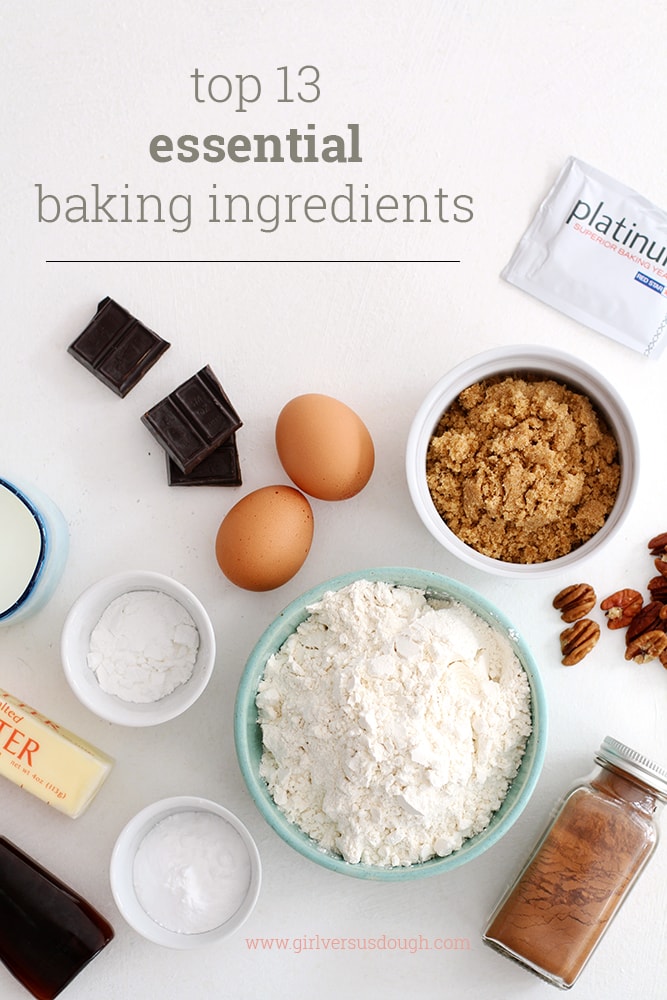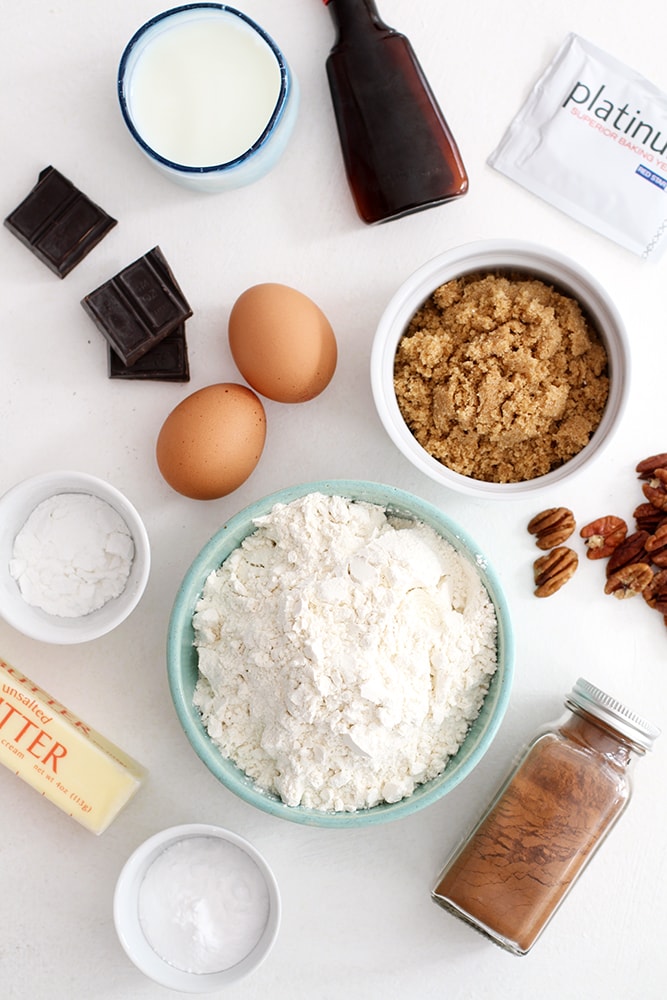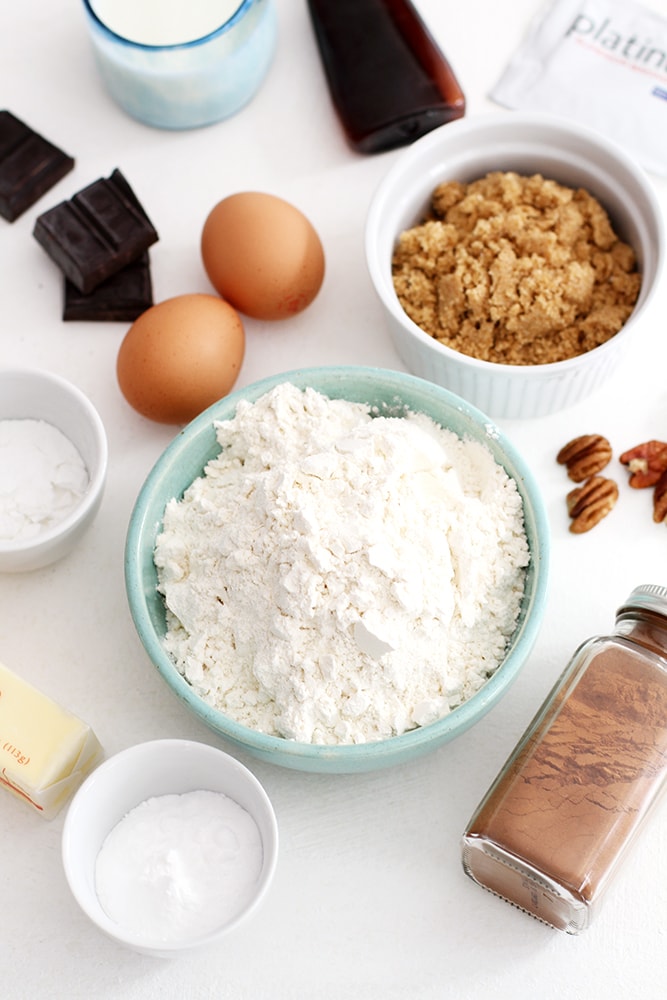a baker’s dozen: my top 13 essential baking ingredients

This post is the second in a short series I’ll be doing this month on the blog called “A Baker’s Dozen.” Each week, I’ll share a post with 13 (get it?) tips, tricks and/or tools to help you become a better baker (though I think you’re pretty great already). Today’s post: My top 13 essential baking ingredients. Enjoy!
Happy Monday, friends! Is that a contradiction: happy and Monday? I know for some of us it is. For me, it depends. If I’ve got a good week of plans ahead, we’re cool. If not, watch out. I’ve probably got a serious case of the needs-coffee/needs-sleep/needs-a-vacations. I’m sure you can empathize.
Thankfully, this week I actually AM on vacation (which, if you read my last post, comes at a good time). This is the first time since like, college, that I’ve been on a tropical vacation in January. For those of us who live in the tundra that is Minnesota or anywhere in the upper half of the country, you know this is a welcome reprieve from the cold. And henceforth, I plan to have a vacation scheduled for EVERY January of EVERY year. It’s a lofty resolution (says my wallet) but I’m going for it.
So let’s pull up a beach chair, sip on some mojitos and have a chat about my top 13 essential baking ingredients, shall we? That seems normal.

My Top 13 Essential Baking Ingredients
I am actually nerd-ily excited to share this post with you today because few things make me happier than a well-stocked, well-organized baking pantry. It’s the baker in me. It’s the Type A in me. It’s the perfectionist in me. It’s all the things that I equally appreciate and can’t stand about myself. So let’s get personal and talk about the 13 ingredients you need to have in your own baking pantry so you can bake pretty much anything, at any time, mmk?
I should probably put down that mojito for a sec.
Note: These ingredients are specified for a standard kitchen — without allergy or dietary restrictions. So if you can’t or don’t use butter or eggs or regular flour, these same guidelines apply for your personal substitutes of choice.
Flour: This encompasses all the flours, but if you want a succinct list of necessary flours you should always have on hand, I say make it all-purpose, whole wheat and bread flours. I make sure my pantry is always well-stocked with these three types of flours, and any other flours — cake flour, gluten free flours, etc. — are just really nice bonuses.
Baking powder: This is a leavening agent that causes baked goods to rise while baking, and it’s pretty much necessary for all types of baked goods, from quick breads to cakes. Seriously, always have this on hand.
Baking soda: This is a leavening agent that, when combined with an acidic ingredient (like buttermilk, yogurt, etc.) causes baked goods to rise while baking. Again, very necessary.
Butter: Is this even a question? No baker should ever be without butter. Period. Unsalted butter is always best for baking so you can control the salt content in your recipes, and I like to have a few bars stored in the fridge and a backup stash in the freezer so I am never without the precious ingredient.
Sugar: Granulated sugar, brown sugar, powdered sugar — you should have all three on hand and more, if you desire (including raw sugar, sugar substitutes, etc.). Each is essential for certain components of baking (granulated and brown sugar for cakes and quick breads, powdered sugar for frosting and whipped creams). I store mine in well-sealed containers on my countertop with an extra stash in the fridge to keep it fresh and free from unwanted critters (if you’ve been there, you know).
Vanilla: Repeat after me — pure. vanilla. extract. Anything else is sub-par and should not set residence in your baking pantry. Now I’ll step off my soapbox.
Eggs: Eggs, while on their own make for a delicious breakfast, are also a mainstay of cakes, breads, pancakes, etc. We are egg-obsessed in our house (“acks,” as the tot likes to call them) so we always have at least two dozen in our fridge, but you should always have at least a half-dozen stored away for baking purposes.
Milk: I usually use whatever milk we have on hand (whole and/or 1%), though many bakers swear by using whole milk for every recipe. This is your call, but because I’m pretty cheap and lazy, I always use whatever is in the fridge. Don’t tell anyone.

Heavy cream: I’m guilty of not always having heavy cream in my fridge and it always tends to be when I need it — to make whipped cream, or to add to ice cream, or to use in a baked good. No one should ever have to go without any of the above, so don’t be like me and instead make sure you always have a small jug of it in the back of the fridge.
Chocolate: This encompasses all the chocolate — from unsweetened baking chocolate squares to semisweet chocolate chips to cocoa powder. I always keep a healthy stash of these ingredients in my baking pantry and I find myself going for them at least once a week (and yes, that includes times when I sprinkle a few chocolate chips on a spoonful of peanut butter. Necessary). A baking pantry without chocolate is a sad pantry indeed.
Nuts: I am a bit of a nut for snacking nuts (har har) so I always have mixed nuts in our pantry for this purpose. But it’s also helpful to have a few nuts that are often used for baking, including pecans, walnuts, almonds, hazelnuts and pistachios. I keep mine in the fridge so they stay fresh (you can store them in the freezer for the same purpose, as well).
Spices: I’m guessing if you do any cooking or baking, you have at least one spice in your home. Good. If you’re a baker, you should have a set of the following: ground cinnamon, whole or ground nutmeg, ground allspice, ground ginger and ground cloves. You’ll use these more often than any other spices for baking purposes. Bonus spices: cayenne pepper, cardamom, cream of tartar and vanilla beans. If you have all of these, I bequeath to you a virtual gold star!
Yeast: If you’re a bread baker, you must have yeast in your baking pantry. I have both active dry yeast and instant yeast on hand all the time, but if you only have room for one, make it active dry yeast. Buy it in the pre-measured packages or the jars, and to keep it extra fresh, store it in the freezer. When you get that hankering for fresh-baked bread, you’ll know where to go.
P.S. Want more of this series? Check out my post on my top 13 essential baking tools and top 13 baking tips and tricks.

I love this new series you’ve got going on, sister! This post reminds me that I had better replenish my chocolate supply lest I run out at an inopportune moment…that would be a disaaaaaastaaah! Keep the tips coming and I hope you’re having the most marvelous vacation! xo
Love a dove this series. Keep it UP!
This is such a fun series!!! Love this idea Steph. Can’t wait to follow along.
Yay for vacations!!! Alex and I just booked a trip with his mom, brother and sister to go to Exuma in April and I can’t wait. Beaches are the best. 🙂 Hope you’re enjoying being a bum for a little while!
I love this blog series! Such a fun way to kick off the year. Totally agree with these 13 essential baking ingredients — especially nuts! Roasting and baking nuts is an excellent way to add texture and rich flavor to just about anything.
gah I’m also guilty of not having heavy cream on hand when I need it! I so need to get better about that!
And this is why I can always whip up cookies late at night 🙂 Love the list and have a great vacation. It’s 20s here today 🙁
I buy unsalted butter five pounds at a time and keep them stashed in my freezer so I never run out. Excellent list.
I love this list and now I consider myself a baker having everything you named! I had one slight blunder happen to me this week. I have cream of tartar on hand, but I realized it was not good anymore when my cookies fell flat coming out of the oven (full disclosure, the expiration date was — uh oh — 2012!) The cookies still tasted awesome even though they were flat as pancakes.
I agree, having a stocked pantry make it a whole lot easier.
How about having sweetened condensed milk and evaporated milk? Or keeping a tub or two of Cool Whip in the freezer? I have my flour, sugar, brown sugar and cocoa powder in canisters next to my butcher’s block (which is where I create my creation). In the freezer goes my extra flours, yeast and other sundries. You do have a very comprehensive list, and I do agree that having only those would still make someone a master baker, at least by family and friends! BTW, I use a lot of YOUR recipes too!! I just wish I were brave enough, or as dedicated, as you.
I meant to say that I wish that I could be a blogger. And I have more than one creation (I left out an s).
I agree with your list. The one comment I disagree with is keeping packets of yeast around. It is better to buy a jar and extend the life by putting it in the refrigerator or freezer. I prefer using instant yeast since I can keep it in the freezer and have great results.
Brenda D — Good point! I just use my yeast so often that I use the packets before they are in danger of expiring. 🙂 But thanks for the tip!